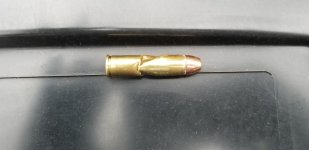This is something, because of it's long length, that happens when reloading for the .460, especially if one is seating and crimping in one step. The cases are unsupported when seating and crimping and are prone to buckling/collapsing if your dies are not set up correctly. When a heavy crimp is being used and you are seating and crimping in one step, the bullet is still being seated while the crimp is starting to be applied and if the crimp "bites" into the cannelure like it's supposed to, too early, it's the case that gives. This is something that is even more common when brass is not of equal lenght. .460 brass is one I always trim to length at least once, either when first loaded as virgin brass, or the first time once fired factory ammo brass is reloaded. Then I keep brass of each batch together throughout their reloading life. IME, the Hornady brass is more prone. The solution is to either trim your brass or at least sort by length. The seat and crimp in separate steps. Or, accept that occasionally you will crush/bulge brass.




